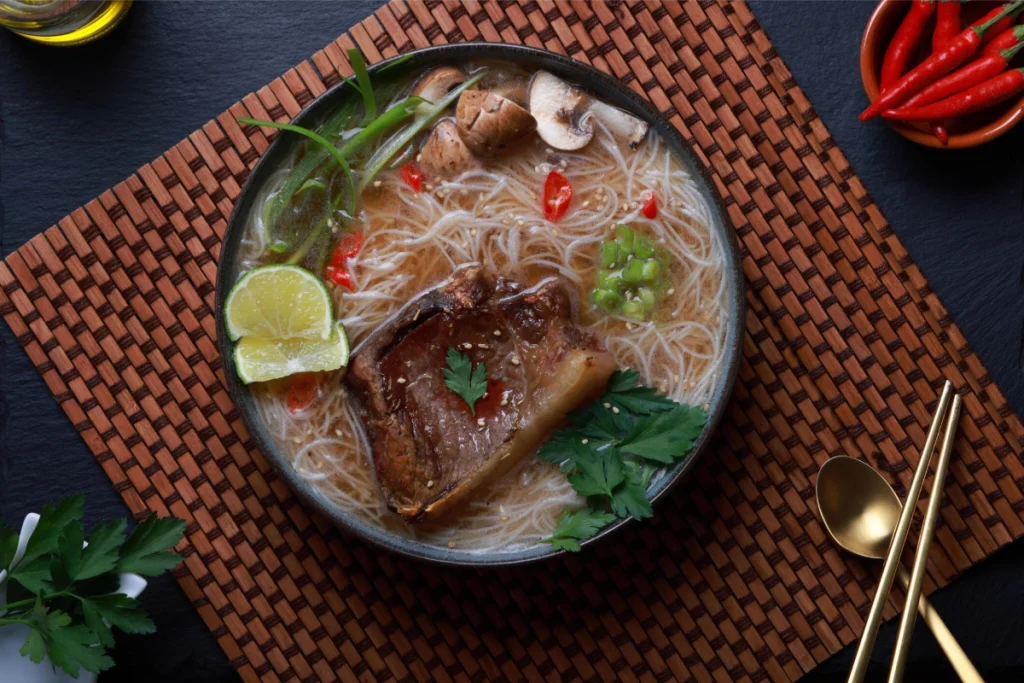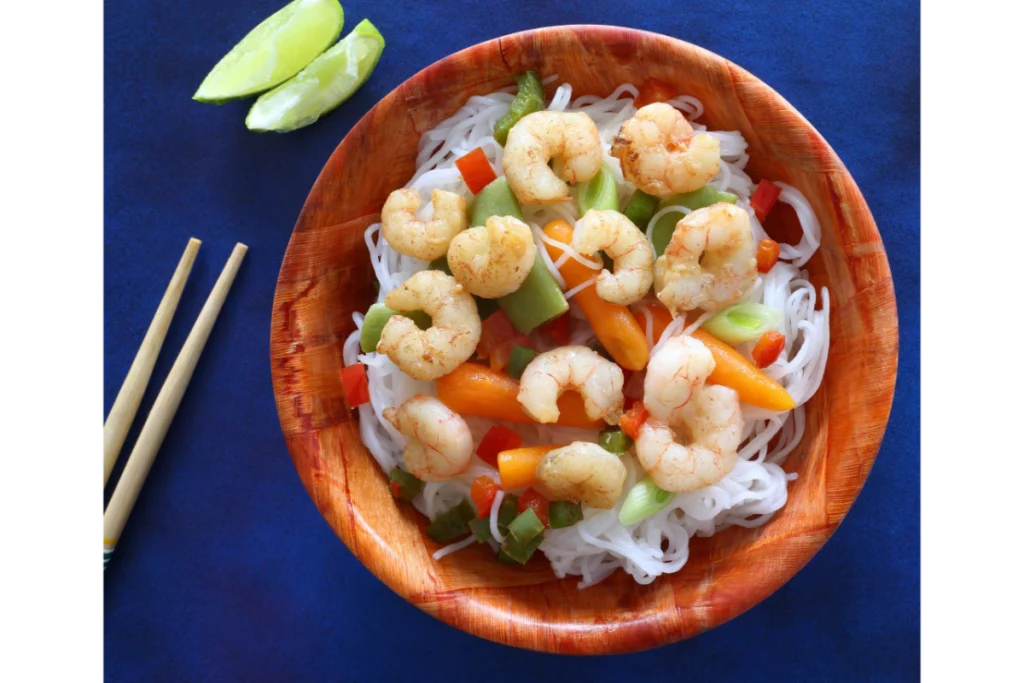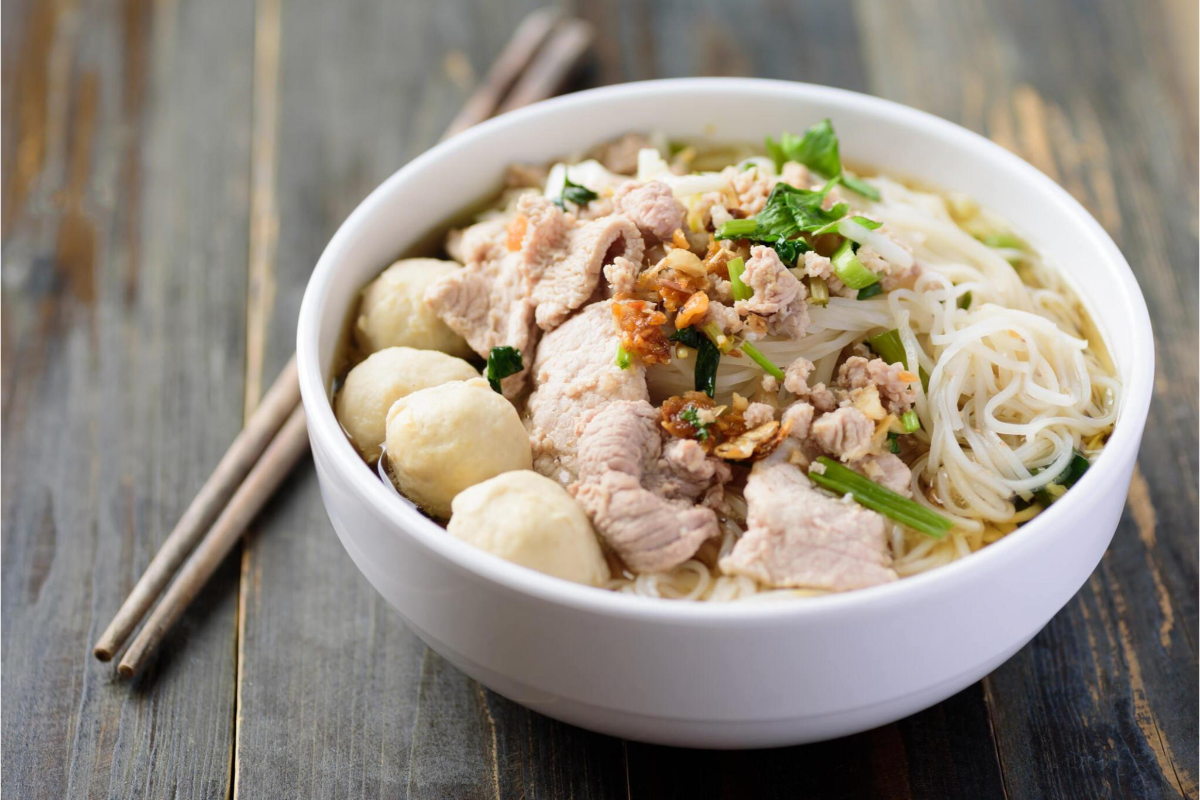Rice noodles have gained a loyal following in kitchens worldwide. Whether you’re whipping up a spicy stir-fry or indulging in a comforting bowl of soup, they offer a deliciously versatile alternative to wheat-based noodles. But here’s the burning question: Are rice noodles gluten-free? For anyone managing celiac disease or gluten sensitivity, understanding what’s in your food is critical.
In this article, we’ll unravel the truth about rice noodles and explore how they compare to other popular options like glass noodles and cup noodles. Along the way, we’ll share health tips, gluten-free recipes, and answers to some of the most common noodle-related questions. Let’s dig in!
Part 1: What Are Rice Noodles?
Rice noodles, as the name suggests, are made primarily from rice flour and water. They’re a staple in Asian cuisine, used in dishes like Pad Thai, Pho, and stir-fries. Their slightly chewy texture and ability to absorb flavors make them a crowd favorite. Unlike wheat noodles, which rely on gluten for structure, rice noodles hold together thanks to their starchy composition.
The Ingredients That Make Rice Noodles
The beauty of rice noodles lies in their simplicity. Traditional recipes call for just two ingredients: rice flour and water. Occasionally, tapioca starch is added for extra elasticity, particularly in wider varieties. Notably, these ingredients are naturally gluten-free, making them a safe choice for those avoiding gluten.
Nutritional Value of Rice Noodles
These noodles pack a punch in terms of carbohydrates, making them an excellent energy source. However, they’re low in protein and fiber, so pairing them with nutrient-dense ingredients is key. For those on gluten-free diets, rice noodles are a lifesaver—so long as they’re labeled gluten-free to ensure no cross-contamination occurred during production.
How Do They Compare to Wheat-Based Noodles?
Wheat noodles owe their elasticity to gluten, a protein that gives them a distinct bite. Rice noodles, on the other hand, are more delicate. Their mild flavor complements bold sauces, while their soft texture caters to those who find wheat-based noodles too heavy. But here’s the kicker: wheat noodles are off-limits for anyone with gluten intolerance, making rice noodles a far superior option.
Are Rice Noodles Truly Gluten-Free?
While the base ingredients are gluten-free, caution is necessary. Cross-contamination during processing is a potential risk. For example, manufacturers that handle wheat products might use shared equipment. To be sure, always check for certifications like the FDA’s gluten-free label【10】.
Ready to explore how rice noodles stack up against other varieties? Stay tuned for Part 2, where we’ll dive into a noodle showdown between rice, glass, and cup noodles!
Part 2: Rice Noodles vs. Other Noodles
Rice noodles might be a fan favorite, but how do they measure up to other popular types like glass noodles and cup noodles? Let’s dive into their differences, textures, ingredients, and whether they make the gluten-free cut.
How Do Rice Noodles Compare to Glass Noodles?
At first glance, rice noodles and glass noodles might look similar, but they’re quite different in composition and characteristics.
- Ingredients: While rice noodles are made from rice flour and water, glass noodles are typically crafted from starches like mung bean, sweet potato, or tapioca.
- Appearance: When cooked, rice noodles retain an opaque white appearance, while glass noodles live up to their name with a translucent, glossy finish.
- Gluten-Free Status: Both types can be gluten-free, but the key is in the labeling. Glass noodles made purely from starch and water are usually safe for gluten-sensitive individuals. However, cross-contamination risks apply here too, so always double-check packaging.
What About Cup Noodles? Are They Gluten-Free?
Cup noodles dominate convenience food aisles and dorm room dinners. But are they a friend or foe to the gluten-free crowd?
- Ingredients Analysis: Traditional cup noodles are made with wheat flour, which is a big no for gluten-free diets. However, some brands now offer gluten-free alternatives made with rice noodles or other safe substitutes.
- Cross-Contamination Risks: Gluten-free cup noodles are a growing market, but always confirm the certification. Reading the ingredient list is critical, as some flavors may sneak in gluten-containing additives or seasonings.
Which One’s the Better Choice?
When choosing between these noodle types, your decision boils down to dietary preferences and culinary needs:
- For a hearty meal that absorbs sauces well, opt for rice noodles.
- For a light, slippery texture perfect in soups or salads, go with glass noodles.
- And if convenience is key, explore gluten-free cup noodle brands for quick, satisfying meals.
Rice noodles clearly hold their own in the noodle showdown, but what about their role in the kitchen? In Part 3, we’ll take you through gluten-free recipes and creative ways to enjoy rice noodles at home!

Part 3: Recipes Featuring Rice Noodles
Rice noodles are incredibly versatile, making them a favorite for various dishes ranging from soups to stir-fries. If you’re looking for gluten-free meal ideas, rice noodles are an excellent choice. Here, we’ll share some popular recipes and tips to make your noodle-based meals not only delicious but also gluten-free.
Popular Recipes Using Rice Noodles
Rice noodles are a key ingredient in many classic dishes, but when you’re aiming for a gluten-free version, it’s essential to be mindful of the other ingredients used. Luckily, these dishes can easily be modified to fit into a gluten-free diet.
- Pad Thai
This Thai stir-fried noodle dish is often made with tamarind paste, fish sauce, and lime, which is naturally gluten-free. Just be sure to choose rice noodles and gluten-free soy sauce. You can add vegetables, shrimp, or chicken to make it a hearty, gluten-free meal. - Pho
A Vietnamese classic, Pho is a flavorful soup made with a rich broth and rice noodles. The broth typically consists of beef bones, herbs, and spices, all of which are gluten-free. Just make sure to double-check the seasonings or any soy sauce used in the recipe. - Stir-Fried Rice Noodles with Vegetables
This simple, quick dish allows you to add any vegetables you like, making it an easy, customizable gluten-free meal. Toss the cooked rice noodles with stir-fried veggies like bell peppers, onions, and broccoli, and season with a gluten-free soy sauce for an instant gluten-free fix.
Chicken and Noodles Recipe with a Gluten-Free Twist
Craving a comforting chicken noodle soup but need it gluten-free? Look no further than this delicious Chicken and Rice Noodle Soup. By swapping out the usual wheat noodles for rice noodles, you can still enjoy the warmth and satisfaction of this classic dish without worrying about gluten.
You’ll Need:
- 1 lb chicken breast (or thighs), cooked and shredded
- 4 cups chicken broth (ensure it’s gluten-free)
- 2 cups water
- 2 cups rice noodles
- 1 onion, thinly sliced
- 2 cloves garlic, minced
- 1 carrot, sliced
- 1 tbsp gluten-free soy sauce
- Fresh cilantro for garnish
Instructions:
- Prepare the Broth
In a large pot, combine chicken broth, water, and gluten-free soy sauce. Bring to a simmer. - Cook the Noodles
In a separate pot, cook the rice noodles according to the package instructions. Drain and set aside. - Combine Ingredients
Add the shredded chicken, onion, garlic, and carrot to the simmering broth. Let it cook for about 5 minutes until the vegetables are tender. - Serve
Divide the cooked rice noodles among bowls and pour the hot broth mixture over the top. Garnish with fresh cilantro.
This dish is light, filling, and packed with flavor. It’s perfect for a cozy meal on a cool evening and works beautifully for anyone looking to stay within a gluten-free diet.
Part 4: Health and Dietary Concerns
For anyone following a gluten-free diet, whether due to celiac disease or gluten sensitivity, it’s essential to understand both the benefits and potential risks when consuming rice noodles. While these noodles are often considered a safe option, there are health and dietary factors to keep in mind. Let’s explore the health benefits of rice noodles, as well as some precautions to ensure you’re enjoying them safely.
Why Gluten-Free Matters
Gluten is a protein found in wheat, barley, and rye, and for people with celiac disease or a gluten intolerance, consuming gluten can cause severe digestive distress and long-term damage to the intestines. Even small traces of gluten can trigger symptoms like bloating, abdominal pain, and fatigue.
For those with celiac disease, it’s not just about avoiding bread or pasta; it’s about being vigilant with all foods, including noodles. That’s why it’s so important to ensure that your noodles are truly gluten-free and don’t come into contact with any wheat during manufacturing.
Fortunately, rice noodles are naturally gluten-free, but cross-contamination can still occur. This means that, when buying rice noodles, you should always look for a gluten-free certification on the label to guarantee they meet the standards set by organizations like the FDA.
Are Rice Noodles Always Safe?
While rice noodles themselves are typically gluten-free, there are a few key considerations when it comes to safety:
- Cross-Contamination Risk:
Cross-contamination occurs when gluten-containing ingredients come into contact with rice noodles during processing or packaging. This can happen in facilities that also process wheat products. So, while the noodles may seem safe, the risk of contamination is still a concern. To minimize this risk, always look for products labeled as gluten-free to ensure they were produced in a dedicated gluten-free facility. - Checking the Ingredient List:
Rice noodles might contain additional ingredients, like sauces or flavorings, that could include gluten. For instance, some brands might add soy sauce, which traditionally contains wheat. Always read the label carefully to check for any hidden gluten sources. - Check for Added Starches or Fillers:
In some cases, rice noodles are made with a combination of rice flour and other starches, such as tapioca or cornstarch, to improve texture. While these ingredients are generally safe for gluten-free diets, it’s still important to ensure the noodles don’t include any wheat-derived starches. Look for reputable brands that clearly list their ingredients.
Gluten-Free Certification and Labeling
For those with strict dietary needs, one of the easiest ways to ensure you’re getting safe rice noodles is by looking for products that are certified gluten-free by trusted organizations like the FDA or Gluten-Free Certification Organization (GFCO). These certifications ensure that the noodles meet stringent standards for gluten-free claims, reducing the risk of cross-contamination.
Additionally, some manufacturers go a step further by producing rice noodles in dedicated gluten-free facilities, which guarantees that their products are free from any trace of gluten. This is especially important if you’re highly sensitive or have been diagnosed with celiac disease.
Health Benefits of Rice Noodles
Rice noodles are low in fat and often lower in calories compared to their wheat-based counterparts. They’re also a good source of carbohydrates, which makes them an excellent energy source for athletes or anyone needing an energy boost throughout the day. However, because rice noodles are low in fiber and protein, it’s best to pair them with a variety of nutrient-dense vegetables, lean proteins, or legumes to make a balanced meal.
For individuals with a gluten intolerance, rice noodles provide a tasty and versatile option that fits seamlessly into gluten-free diets. Plus, when combined with nutrient-rich vegetables and lean proteins, they can offer a filling and satisfying meal.
Important Health Note:
If you have celiac disease or non-celiac gluten sensitivity, it’s crucial to stay informed about any potential cross-contamination issues with food products. Always verify that your rice noodles are certified gluten-free and prepared in a gluten-free facility to ensure they meet safety standards.
In the next part, we’ll answer some of the most frequently asked questions about rice noodles and gluten, diving into common concerns and clearing up any confusion. Stay with us as we continue exploring everything you need to know about these tasty noodles!

Part 5: FAQs About Rice Noodles and Gluten
If you’re new to the world of gluten-free eating or just looking to deepen your knowledge, you probably have some burning questions about rice noodles. Don’t worry! In this section, we’ll tackle the most commonly asked questions related to rice noodles and gluten to clear up any confusion and make your decision-making easier.
Are All Rice Noodles Gluten-Free?
Great question! While rice noodles are typically made from rice flour and water, they are not automatically gluten-free in every instance. This is mainly due to the potential for cross-contamination during manufacturing. If rice noodles are processed in a facility that also handles wheat or other gluten-containing grains, there’s a risk of contamination.
To be absolutely certain, always look for a gluten-free certification on the package. This guarantees that the noodles meet the necessary standards and have been processed in a dedicated gluten-free facility.
How Do You Check If Noodles Are Gluten-Free?
It’s always a good idea to double-check the labels and ingredients list. To be sure the noodles are gluten-free, look for the following:
- Gluten-Free Certification: Trusted organizations like the FDA or GFCO (Gluten-Free Certification Organization) provide this stamp of approval.
- Ingredient List: Ensure that no wheat, barley, or rye ingredients are listed. Some noodle types may have hidden gluten, such as in flavoring packets or sauces.
- Manufacturing Information: Some brands will mention whether they are made in a dedicated gluten-free facility to reduce the risk of cross-contamination.
Can I Use Rice Noodles in Place of Wheat Noodles?
Absolutely! Rice noodles are an excellent substitute for wheat noodles, especially if you’re following a gluten-free diet. They work well in many dishes like stir-fries, soups, and salads. Keep in mind, however, that rice noodles have a softer, more delicate texture compared to wheat noodles, which may alter the final result slightly, but in the best way possible!
Rice noodles are perfect in dishes like Pad Thai, Pho, and even a simple stir-fry, giving your meal the same hearty satisfaction as traditional wheat noodles—without the gluten.
Are Cup Noodles Safe for a Gluten-Free Diet?
Unfortunately, most cup noodles contain wheat flour, which means they are not suitable for a gluten-free diet. However, there are gluten-free versions of cup noodles available now, often made with rice noodles or other gluten-free alternatives. These cup noodles will clearly state “gluten-free” on the packaging, so be sure to check the label. Additionally, avoid any cup noodles that include flavoring packets that may contain gluten or wheat-based products.
Are Rice Noodles Low in Calories?
Yes, rice noodles tend to be lower in calories compared to other types of noodles, particularly wheat-based noodles. This makes them a great choice for those looking to control their calorie intake. However, like any food, the overall healthiness of your rice noodle dish depends on what you pair them with. For a balanced meal, combine rice noodles with plenty of fresh veggies, lean protein, and gluten-free seasonings or sauces to create a nutritious dish that is both filling and low-calorie.
Can Rice Noodles Be Used for Weight Loss?
Since rice noodles are lower in fat and calories, they can certainly fit into a weight-loss diet. They are a great alternative to more calorie-dense pasta or wheat noodles, especially when paired with vegetables and lean proteins. However, it’s important to note that, like any carbohydrate, rice noodles should be consumed in moderation. Too many carbs, even gluten-free ones, can lead to weight gain if not balanced properly with other macronutrients.
Pro Tip:
If you’re trying to make your rice noodle dishes even healthier, consider adding more vegetables or lean proteins like chicken, tofu, or shrimp. This will boost the dish’s nutritional value and make it more filling without adding unnecessary calories.
In Part 6, we’ll wrap things up with some final thoughts on the benefits of rice noodles and a few tips on making the best gluten-free meals at home. Stay tuned!
Part 6: Conclusion – Enjoying Rice Noodles on a Gluten-Free Diet
Rice noodles are a fantastic, versatile ingredient for anyone following a gluten-free diet. Not only are they naturally free from gluten, but they’re also delicious, easy to prepare, and perfect for a variety of dishes. Whether you’re craving a comforting chicken and noodles recipe, a savory Pad Thai, or a fresh, healthy stir-fry, rice noodles provide a gluten-free solution that doesn’t sacrifice flavor or texture.
By choosing certified gluten-free rice noodles and being mindful of potential cross-contamination risks, you can confidently enjoy this noodle alternative without worrying about gluten. And with so many creative recipes at your fingertips, the possibilities are endless!
Tips for Making the Best Gluten-Free Rice Noodle Dishes:
- Pair With Fresh Ingredients: Combine your rice noodles with fresh vegetables, lean proteins, and gluten-free seasonings for a balanced and nutritious meal.
- Mind the Packaging: Always check for gluten-free certifications to ensure the noodles are truly safe for those with celiac disease or gluten sensitivity.
- Experiment With Sauces: Rice noodles are a blank canvas, so try them with different sauces like tamari (a gluten-free soy sauce) or homemade broth for added flavor.
- Enjoy Them in Various Ways: From soups to salads to stir-fries, rice noodles are incredibly adaptable, making them perfect for any meal of the day.
Whether you’re new to gluten-free eating or a seasoned pro, rice noodles are a staple that’s both delicious and safe for most dietary needs. Happy cooking!
Feel free to explore more ideas and recipes using rice noodles for a healthy and satisfying gluten-free meal. Rice noodles are truly a versatile option that allows you to enjoy delicious meals without compromising your health or taste preferences.

